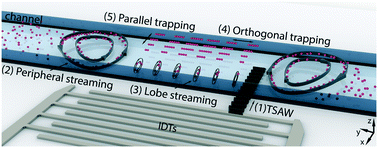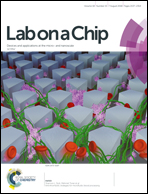Surface acoustic wave diffraction driven mechanisms in microfluidic systems†
Abstract
Acoustic forces arising from high-frequency surface acoustic waves (SAW) underpin an exciting range of promising techniques for non-contact manipulation of fluid and objects at micron scale. Despite increasing significance of SAW-driven technologies in microfluidics, the understanding of a broad range of phenomena occurring within an individual SAW system is limited. Acoustic effects including streaming and radiation force fields are often assumed to result from wave propagation in a simple planar fashion. The propagation patterns of a single SAW emanating from a finite-width source, however, cause a far richer range of physical effects. In this work, we seek a better understanding of the various effects arising from the incidence of a finite-width SAW beam propagating into a quiescent fluid. Through numerical and experimental verification, we present five distinct mechanisms within an individual system. These cause fluid swirling in two orthogonal planes, and particle trapping in two directions, as well as migration of particles in the direction of wave propagation. For a range of IDT aperture and channel dimensions, the relative importance of these mechanisms is evaluated.



 Please wait while we load your content...
Please wait while we load your content...